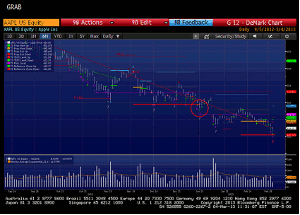Notwithstanding the fact that Apple participated in Tuesday’s tech rally, there’s nothing on its weekly chart to suggest an end to near-term weakness, writes Fil Zucchi on Minyanville.
Many traders who had never heard of Tom DeMark or his indicators before he went on TV to call a bottom on Apple (AAPL) have summarily dismissed and ridiculed his work because the daily Combo 13 Buy failed. Few, if any, of these folks have any clue that the Combo 13 Buy came with a “Risk Level” (i.e. stop level) of $465.01 or $20 below where the stock traded when DeMark argued in favor of buying it (daily chart below).
And of those few, probably a miniscule percentage would care to acknowledge that the monthly DeMark counts—simultaneous Combo Sell 13 and TDST Sell Setup—hinted at closing long standing longs on August 31 of last year with the stock at $665.24 (see below).
I’m pointing this out not to defend DeMark’s studies—they need no defense, especially from me—but to highlight the next two areas of potential selling exhaustion. Those areas are at $405, the daily TD PropExhaustion Down target, and $377, the monthly TDST Level Down price. Note also that on the weekly chart there’s nothing to suggest an end to near-term weakness.
More hocus-pocus, you say? Maybe. But the fundamentals are not arguing for higher prices either, with 2013 adjusted EPS estimates now right at the 2012 number, despite a 15% growth in revenues. Way back when, I argued AAPL’s Achilles' heel was the inevitability of margins compressing back to the mean. In my humble opinion, that process has not ended yet. Over the following several months, I have also discussed on Buzz & Banter certain price ranges I had in mind for AAPL that are proving to have been way too optimistic; so, prescient I have not been in that regard.
But that, in a nutshell, is the AAPL stock story: When will it find enough buyers focused on cash flows and the balance sheet to stand up to those sellers whose vision of never-ending runaway growth has been shattered? I thought that inflection point would have arrived by now, but obviously the euphoria of the mo-mo days was far more widespread than I thought. Or as uber-technician John Roque is fond of saying, when stocks break, they don’t revert to the mean, they revert beyond the mean.
By Fil Zucchi, Contributor, Minyanville




















